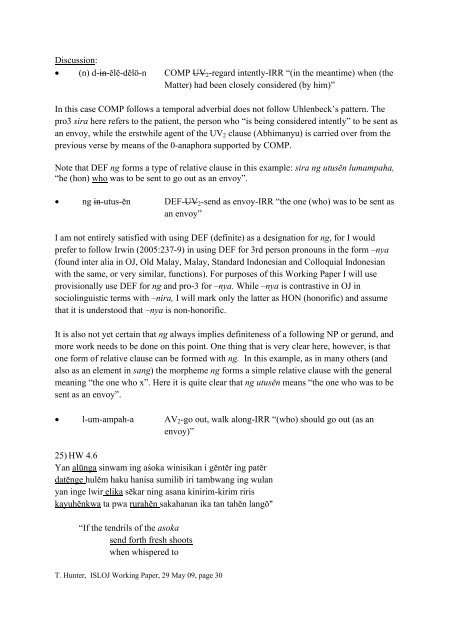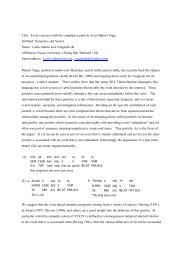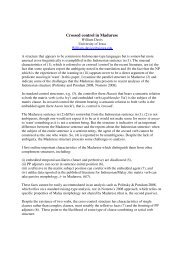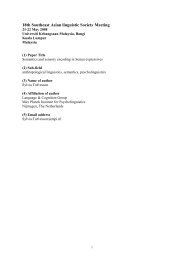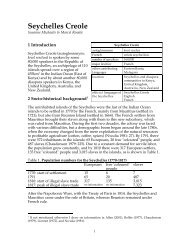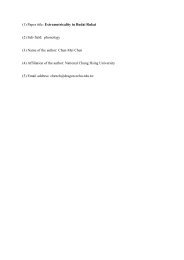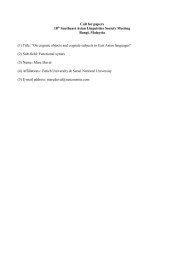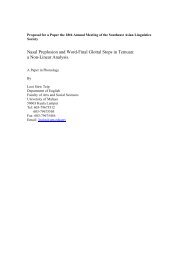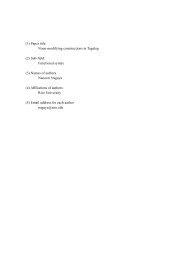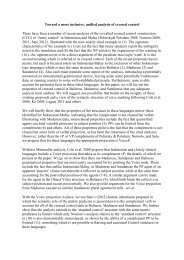Working Paper on Irrealis, Imperative Mode and Complementation ...
Working Paper on Irrealis, Imperative Mode and Complementation ...
Working Paper on Irrealis, Imperative Mode and Complementation ...
You also want an ePaper? Increase the reach of your titles
YUMPU automatically turns print PDFs into web optimized ePapers that Google loves.
Discussi<strong>on</strong>:<br />
(n) d-in-ĕlĕ-dĕlö-n COMP UV2-regard intently-IRR “(in the meantime) when (the<br />
Matter) had been closely c<strong>on</strong>sidered (by him)”<br />
In this case COMP follows a temporal adverbial does not follow Uhlenbeck’s pattern. The<br />
pro3 sira here refers to the patient, the pers<strong>on</strong> who “is being c<strong>on</strong>sidered intently” to be sent as<br />
an envoy, while the erstwhile agent of the UV2 clause (Abhimanyu) is carried over from the<br />
previous verse by means of the 0-anaphora supported by COMP.<br />
Note that DEF ng forms a type of relative clause in this example: sira ng utusĕn lumampaha,<br />
“he (h<strong>on</strong>) who was to be sent to go out as an envoy”.<br />
ng in-utus-ĕn DEF-UV2-send as envoy-IRR “the <strong>on</strong>e (who) was to be sent as<br />
an envoy”<br />
I am not entirely satisfied with using DEF (definite) as a designati<strong>on</strong> for ng, for I would<br />
prefer to follow Irwin (2005:237-9) in using DEF for 3rd pers<strong>on</strong> pr<strong>on</strong>ouns in the form –nya<br />
(found inter alia in OJ, Old Malay, Malay, St<strong>and</strong>ard Ind<strong>on</strong>esian <strong>and</strong> Colloquial Ind<strong>on</strong>esian<br />
with the same, or very similar, functi<strong>on</strong>s). For purposes of this <str<strong>on</strong>g>Working</str<strong>on</strong>g> <str<strong>on</strong>g>Paper</str<strong>on</strong>g> I will use<br />
provisi<strong>on</strong>ally use DEF for ng <strong>and</strong> pro-3 for –nya. While –nya is c<strong>on</strong>trastive in OJ in<br />
sociolinguistic terms with –nira, I will mark <strong>on</strong>ly the latter as HON (h<strong>on</strong>orific) <strong>and</strong> assume<br />
that it is understood that –nya is n<strong>on</strong>-h<strong>on</strong>orific.<br />
It is also not yet certain that ng always implies definiteness of a following NP or gerund, <strong>and</strong><br />
more work needs to be d<strong>on</strong>e <strong>on</strong> this point. One thing that is very clear here, however, is that<br />
<strong>on</strong>e form of relative clause can be formed with ng. In this example, as in many others (<strong>and</strong><br />
also as an element in sang) the morpheme ng forms a simple relative clause with the general<br />
meaning “the <strong>on</strong>e who x”. Here it is quite clear that ng utusĕn means “the <strong>on</strong>e who was to be<br />
sent as an envoy”.<br />
l-um-ampah-a AV2-go out, walk al<strong>on</strong>g-IRR “(who) should go out (as an<br />
envoy)”<br />
25) HW 4.6<br />
Yan alūnga sinwam ing aśoka winisikan i gĕntĕr ing patĕr<br />
ḍatĕnge hulĕm haku hanisa sumilib iri tambwang ing wulan<br />
yan inge lwir elika sĕkar ning asana kinirim-kirim riris<br />
kayuhĕnkwa ta pwa rurahĕn sakahanan ika tan tahĕn langö"<br />
“If the tendrils of the asoka<br />
send forth fresh shoots<br />
when whispered to<br />
T. Hunter, ISLOJ <str<strong>on</strong>g>Working</str<strong>on</strong>g> <str<strong>on</strong>g>Paper</str<strong>on</strong>g>, 29 May 09, page 30


